engine TOYOTA COROLLA 2010 10.G Owners Manual
[x] Cancel search | Manufacturer: TOYOTA, Model Year: 2010, Model line: COROLLA, Model: TOYOTA COROLLA 2010 10.GPages: 476, PDF Size: 9.5 MB
Page 2 of 476
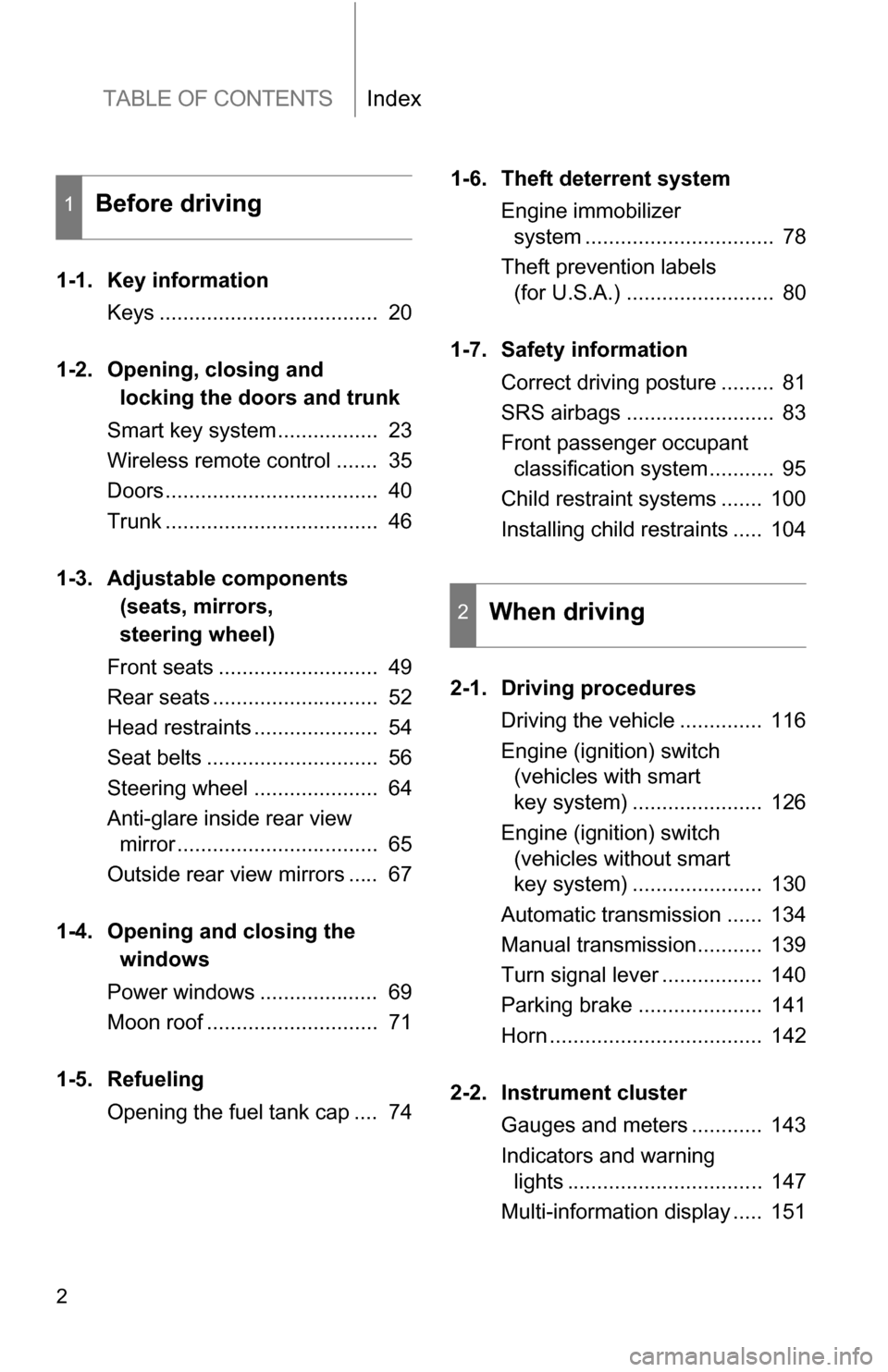
TABLE OF CONTENTSIndex
2
1-1. Key informationKeys ..................................... 20
1-2. Opening, closing and locking the doors and trunk
Smart key system................. 23
Wireless remote control ....... 35
Doors.................................... 40
Trunk .................................... 46
1-3. Adjustable components (seats, mirrors,
steering wheel)
Front seats ........................... 49
Rear seats ............................ 52
Head restraints ..................... 54
Seat belts ............................. 56
Steering wheel ..................... 64
Anti-glare inside rear view mirror .................................. 65
Outside rear view mirrors ..... 67
1-4. Opening and closing the windows
Power windows .................... 69
Moon roof ............................. 71
1-5. Refueling Opening the fuel tank cap .... 74 1-6. Theft deterrent system
Engine immobilizer system ................................ 78
Theft prevention labels (for U.S.A.) ......................... 80
1-7. Safety information Correct driving posture ......... 81
SRS airbags ......................... 83
Front passenger occupant classification system ........... 95
Child restraint systems ....... 100
Installing child restraints ..... 104
2-1. Driving procedures Driving the vehicle .............. 116
Engine (ignition) switch (vehicles with smart
key system) ...................... 126
Engine (ignition) switch (vehicles without smart
key system) ...................... 130
Automatic transmission ...... 134
Manual transmission........... 139
Turn signal lever ................. 140
Parking brake ..................... 141
Horn .................................... 142
2-2. Instrument cluster Gauges and meters ............ 143
Indicators and warning lights ................................. 147
Multi-information display ..... 151
1Before driving
2When driving
Page 4 of 476
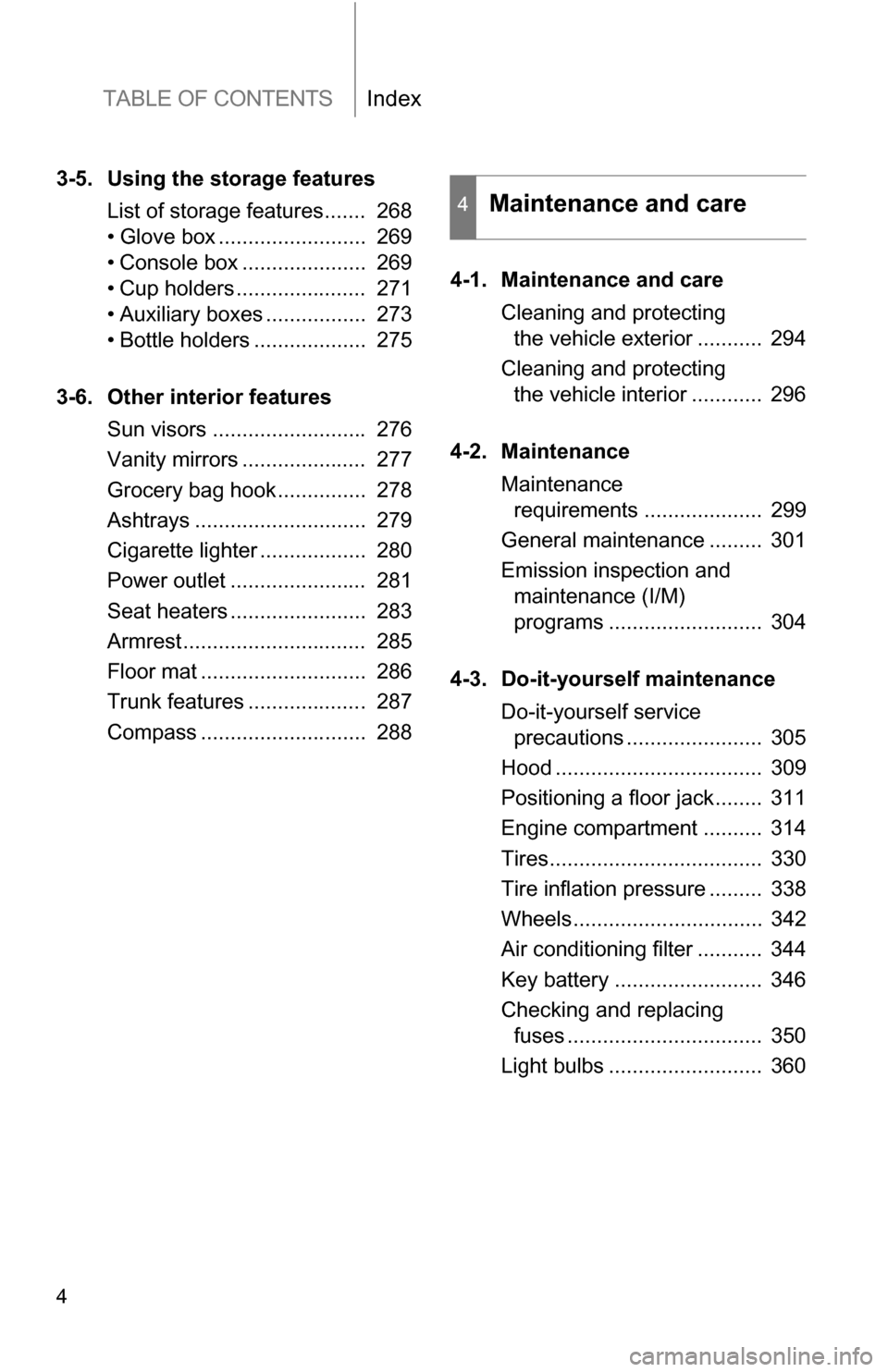
TABLE OF CONTENTSIndex
4
3-5. Using the storage featuresList of storage features....... 268
• Glove box ......................... 269
• Console box ..................... 269
• Cup holders ...................... 271
• Auxiliary boxes ................. 273
• Bottle holders ................... 275
3-6. Other interior features Sun visors .......................... 276
Vanity mirrors ..................... 277
Grocery bag hook............... 278
Ashtrays ............................. 279
Cigarette lighter .................. 280
Power outlet ....................... 281
Seat heaters ....................... 283
Armrest............................... 285
Floor mat ............................ 286
Trunk features .................... 287
Compass ............................ 288 4-1. Maintenance and care
Cleaning and protecting the vehicle exterior ........... 294
Cleaning and protecting the vehicle interior ............ 296
4-2. Maintenance Maintenance requirements .................... 299
General maintenance ......... 301
Emission inspection and maintenance (I/M)
programs .......................... 304
4-3. Do-it-yourself maintenance Do-it-yourself service precautions ....................... 305
Hood ................................... 309
Positioning a floor jack........ 311
Engine compartment .......... 314
Tires.................................... 330
Tire inflation pressure ......... 338
Wheels................................ 342
Air conditioning filter ........... 344
Key battery ......................... 346
Checking and replacing fuses ................................. 350
Light bulbs .......................... 360
4Maintenance and care
Page 5 of 476
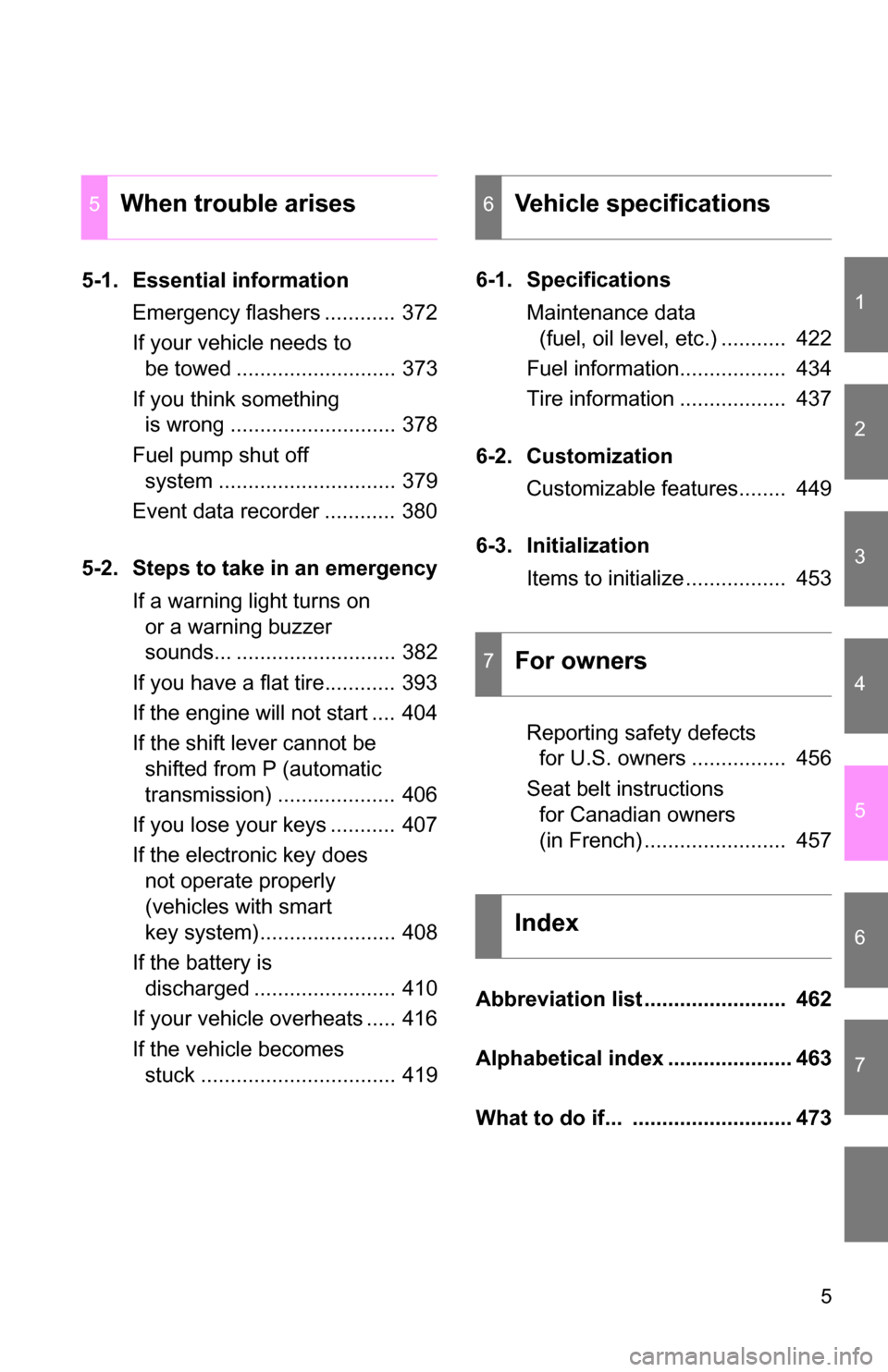
1
2
3
4
5
6
7
5
5-1. Essential informationEmergency flashers ............ 372
If your vehicle needs to be towed ........................... 373
If you think something is wrong ............................ 378
Fuel pump shut off system .............................. 379
Event data recorder ............ 380
5-2. Steps to take in an emergency If a warning light turns on or a warning buzzer
sounds... ........................... 382
If you have a flat tire............ 393
If the engine will not start .... 404
If the shift lever cannot be shifted from P (automatic
transmission) .................... 406
If you lose your keys ........... 407
If the electronic key does not operate properly
(vehicles with smart
key system)....................... 408
If the battery is discharged ........................ 410
If your vehicle overheats ..... 416
If the vehicle becomes stuck ................................. 419 6-1. Specifications
Maintenance data (fuel, oil level, etc.) ........... 422
Fuel information.................. 434
Tire information .................. 437
6-2. Customization Customizable features........ 449
6-3. Initialization Items to initialize ................. 453
Reporting safety defects for U.S. owners ................ 456
Seat belt instructions for Canadian owners
(in French) ........................ 457
Abbreviation list ........................ 462
Alphabetical index ..................... 463
What to do if... ........................... 473
5When trouble arises6Vehicle specifications
7For owners
Index
Page 13 of 476
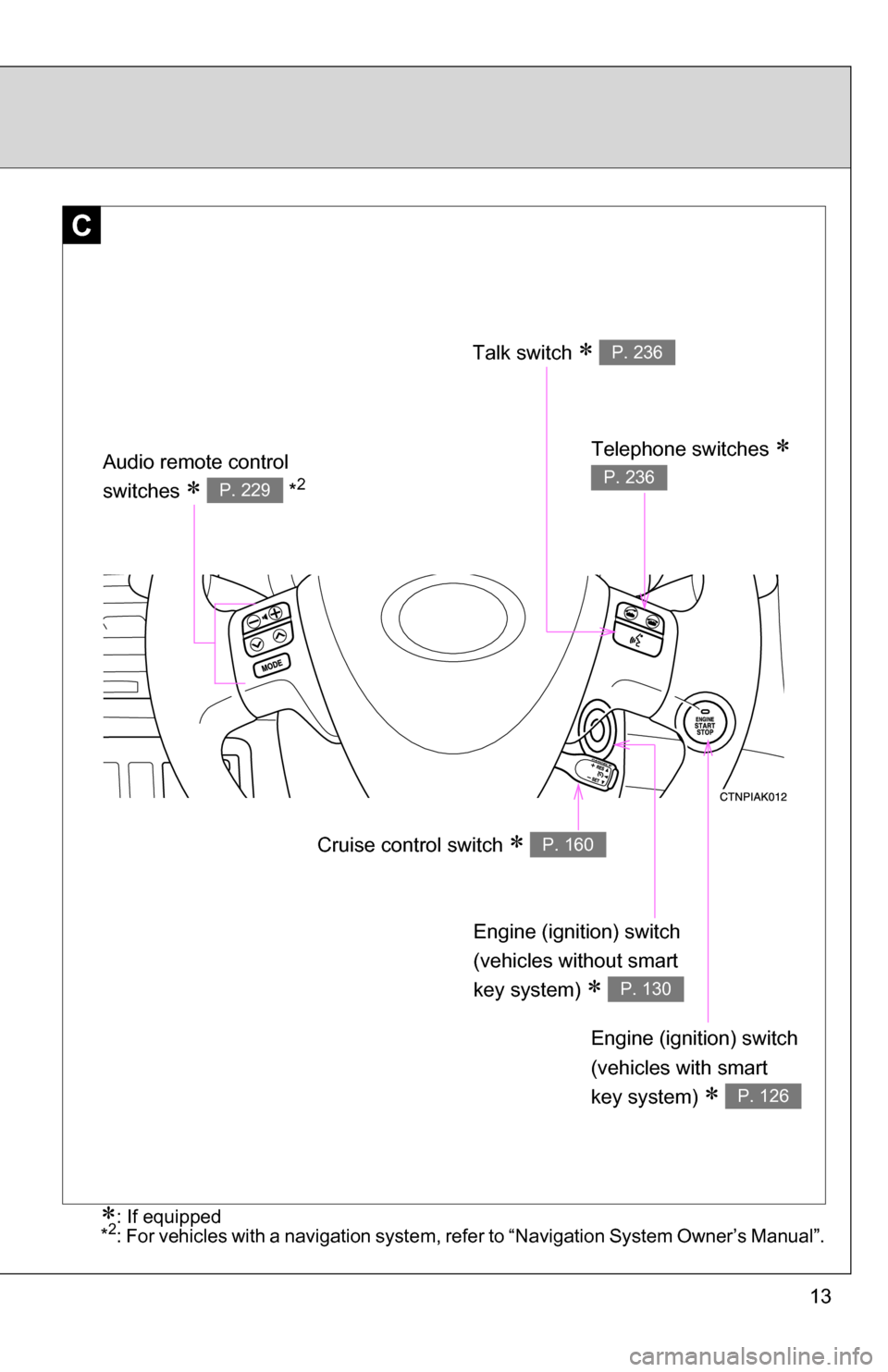
13
C
Cruise control switch P. 160
Talk switch P. 236
Engine (ignition) switch
(vehicles without smart
key system)
P. 130
Engine (ignition) switch
(vehicles with smart
key system)
P. 126
Audio remote control
switches
*2P. 229
Telephone switches
P. 236
: If equipped
*2: For vehicles with a navigation system, refer to “Navigation System Owner’s Manual”.
Page 19 of 476
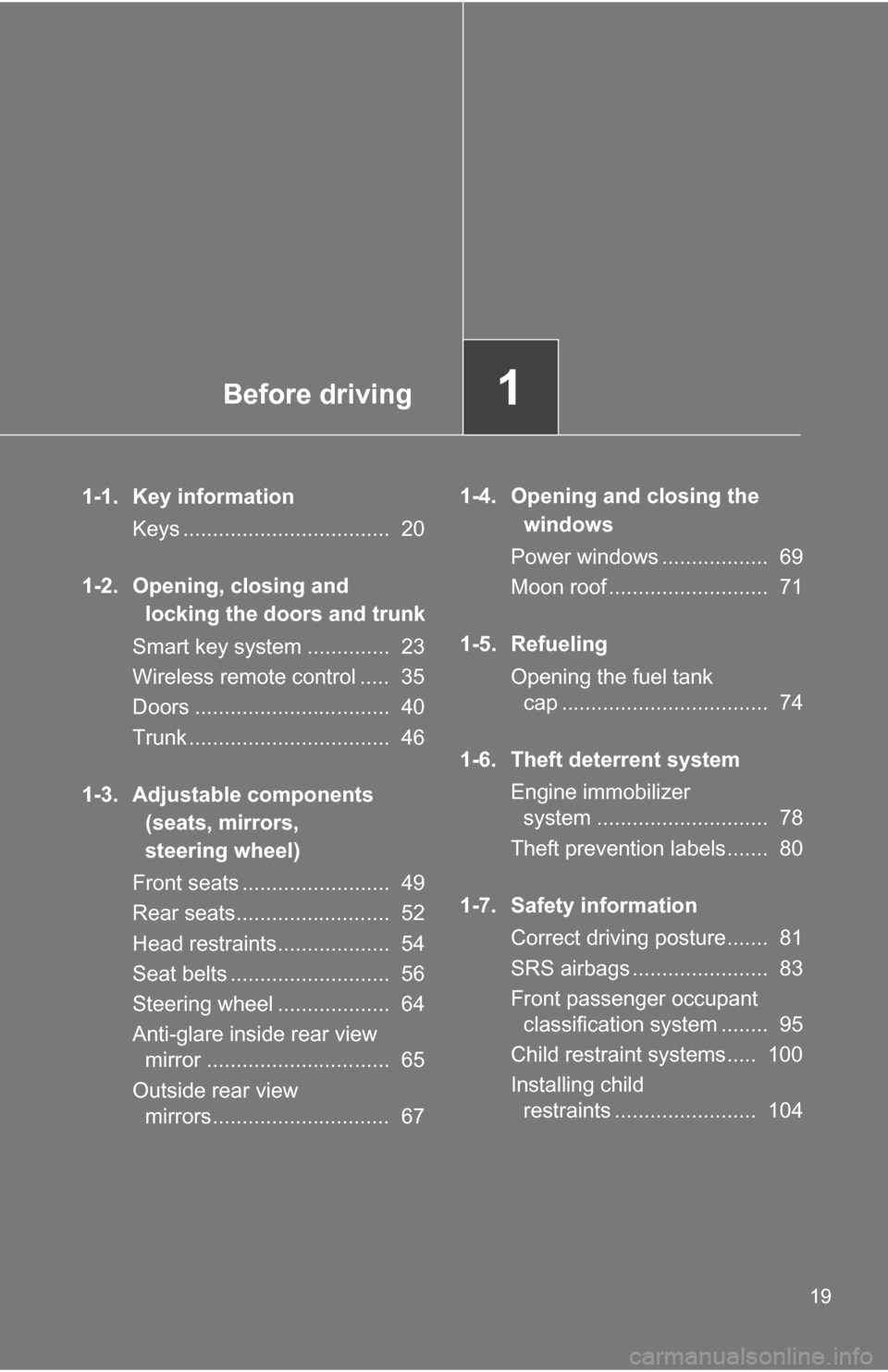
Before driving1
19
1-1. Key informationKeys ................................... 20
1-2. Opening, closing and locking the doors and trunk
Smart key system .............. 23
Wireless remote control ..... 35
Doors ................................. 40
Trunk .................................. 46
1-3. Adjustable components (seats, mirrors,
steering wheel)
Front seats ......................... 49
Rear seats.......................... 52
Head restraints................... 54
Seat belts ........................... 56
Steering wheel ................... 64
Anti-glare inside rear view mirror ............................... 65
Outside rear view mirrors.............................. 67 1-4. Opening and closing the
windows
Power windows .................. 69
Moon roof ........................... 71
1-5. Refueling Opening the fuel tank cap ................................... 74
1-6. Theft deterrent system Engine immobilizer system ............................. 78
Theft prevention labels....... 80
1-7. Safety information Correct driving posture....... 81
SRS airbags ....................... 83
Front passenger occupant classification system ........ 95
Child restraint systems..... 100
Installing child restraints ........................ 104
Page 23 of 476
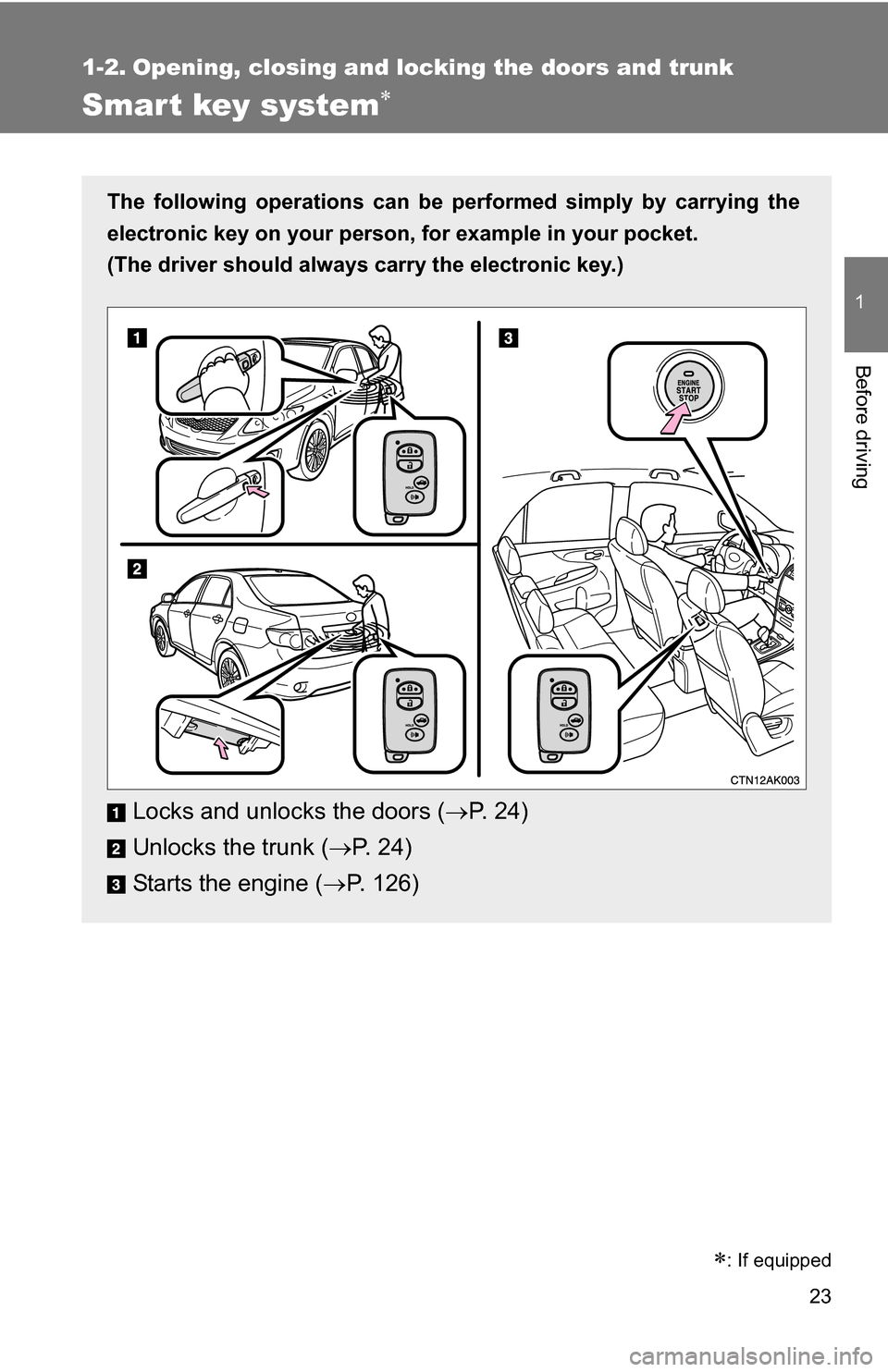
23
1
Before driving
1-2. Opening, closing and locking the doors and trunk
Smart key system
The following operations can be performed simply by carrying the
electronic key on your person, for example in your pocket.
(The driver should always carry the electronic key.)
Locks and unlocks the doors ( P. 2 4 )
Unlocks the trunk ( P. 2 4 )
Starts the engine ( P. 126)
�
: If equipped
Page 26 of 476
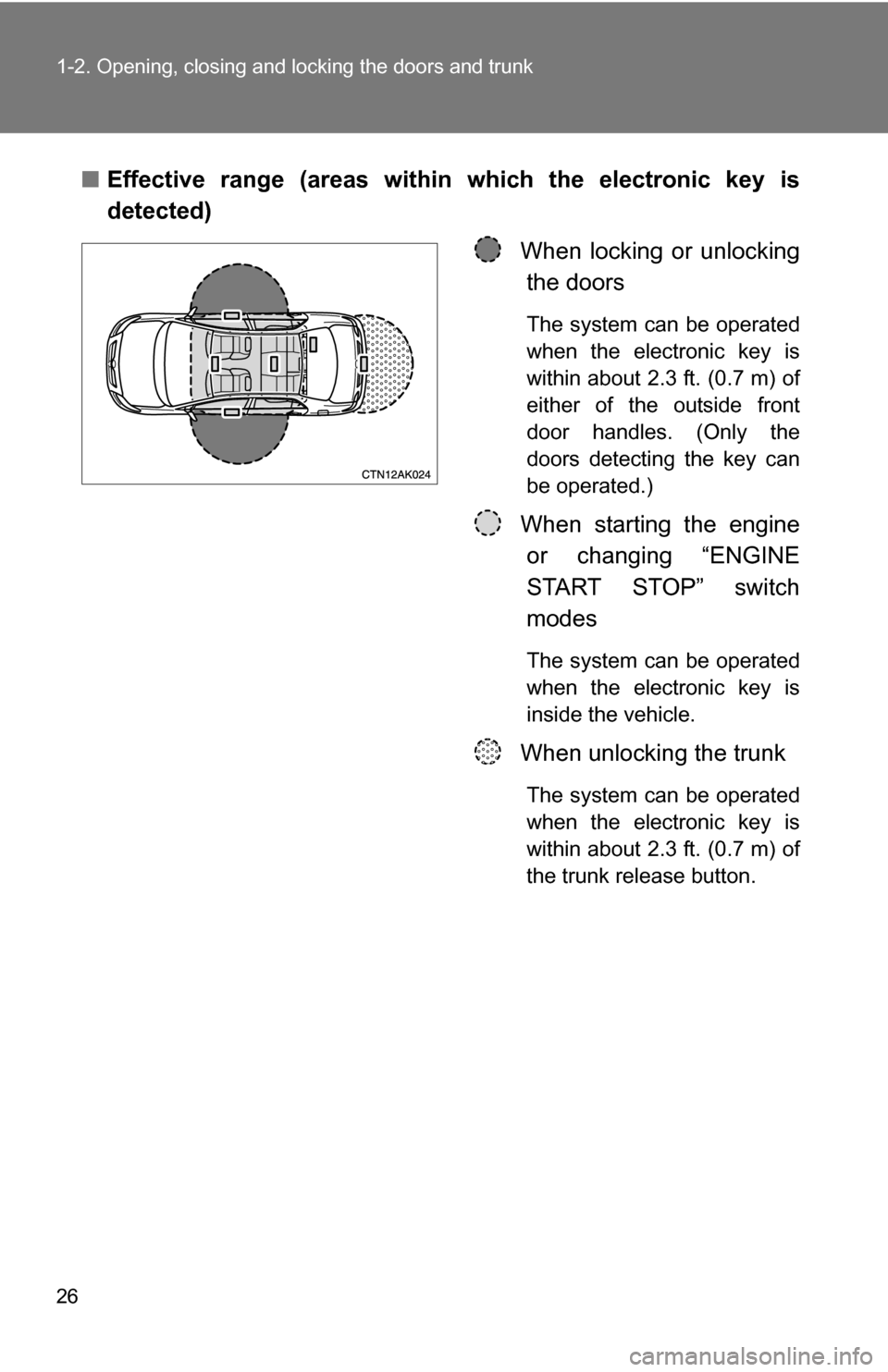
26 1-2. Opening, closing and locking the doors and trunk
■Effective range (areas within which the electronic key is
detected)
When locking or unlockingthe doors
The system can be operated
when the electronic key is
within about 2.3 ft. (0.7 m) of
either of the outside front
door handles. (Only the
doors detecting the key can
be operated.)
When starting the engineor changing “ENGINE
START STOP” switch
modes
The system can be operated
when the electronic key is
inside the vehicle.
When unlocking the trunk
The system can be operated
when the electronic key is
within about 2.3 ft. (0.7 m) of
the trunk release button.
Page 28 of 476
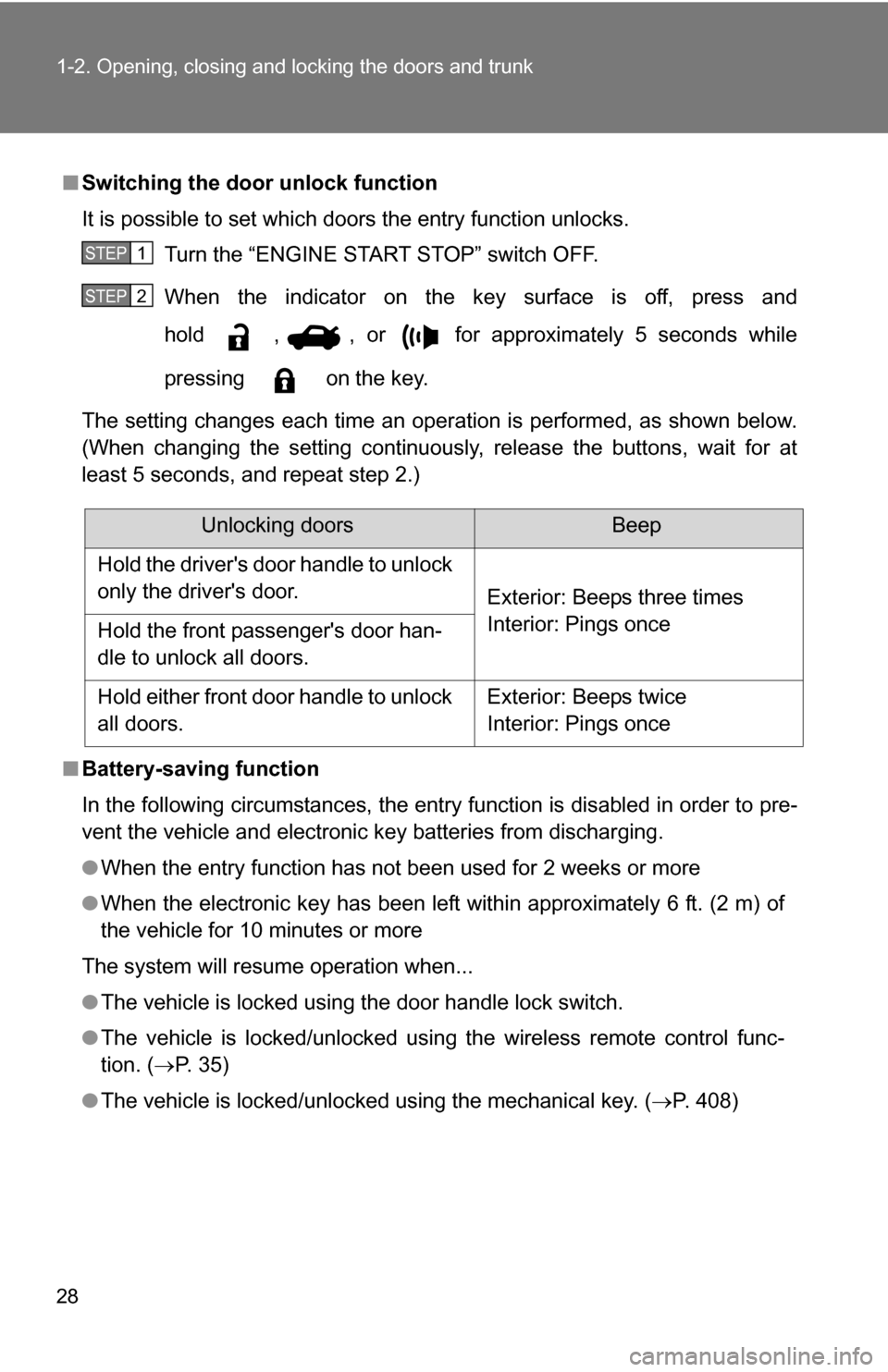
28 1-2. Opening, closing and locking the doors and trunk
■Switching the door unlock function
It is possible to set which doors the entry function unlocks.
Turn the “ENGINE START STOP” switch OFF.
When the indicator on the key surface is off, press and
hold , , or for approximately 5 seconds while
pressing on the key.
The setting changes each time an operation is performed, as shown below.
(When changing the setting continuously, release the buttons, wait for at
least 5 seconds, and repeat step 2.)
■ Battery-saving function
In the following circumstances, the entry function is disabled in order to pre-
vent the vehicle and electronic key batteries from discharging.
●When the entry function has not been used for 2 weeks or more
● When the electronic key has been left within approximately 6 ft. (2 m) of
the vehicle for 10 minutes or more
The system will resume operation when...
● The vehicle is locked using the door handle lock switch.
● The vehicle is locked/unlocked using the wireless remote control func-
tion. ( P. 3 5 )
● The vehicle is locked/unlocked using the mechanical key. ( P. 408)
STEP 1
STEP 2
Unlocking doorsBeep
Hold the driver's door handle to unlock
only the driver's door. Exterior: Beeps three times
Interior: Pings once
Hold the front passenger's door han-
dle to unlock all doors.
Hold either front door handle to unlock
all doors. Exterior: Beeps twice
Interior: Pings once
Page 29 of 476
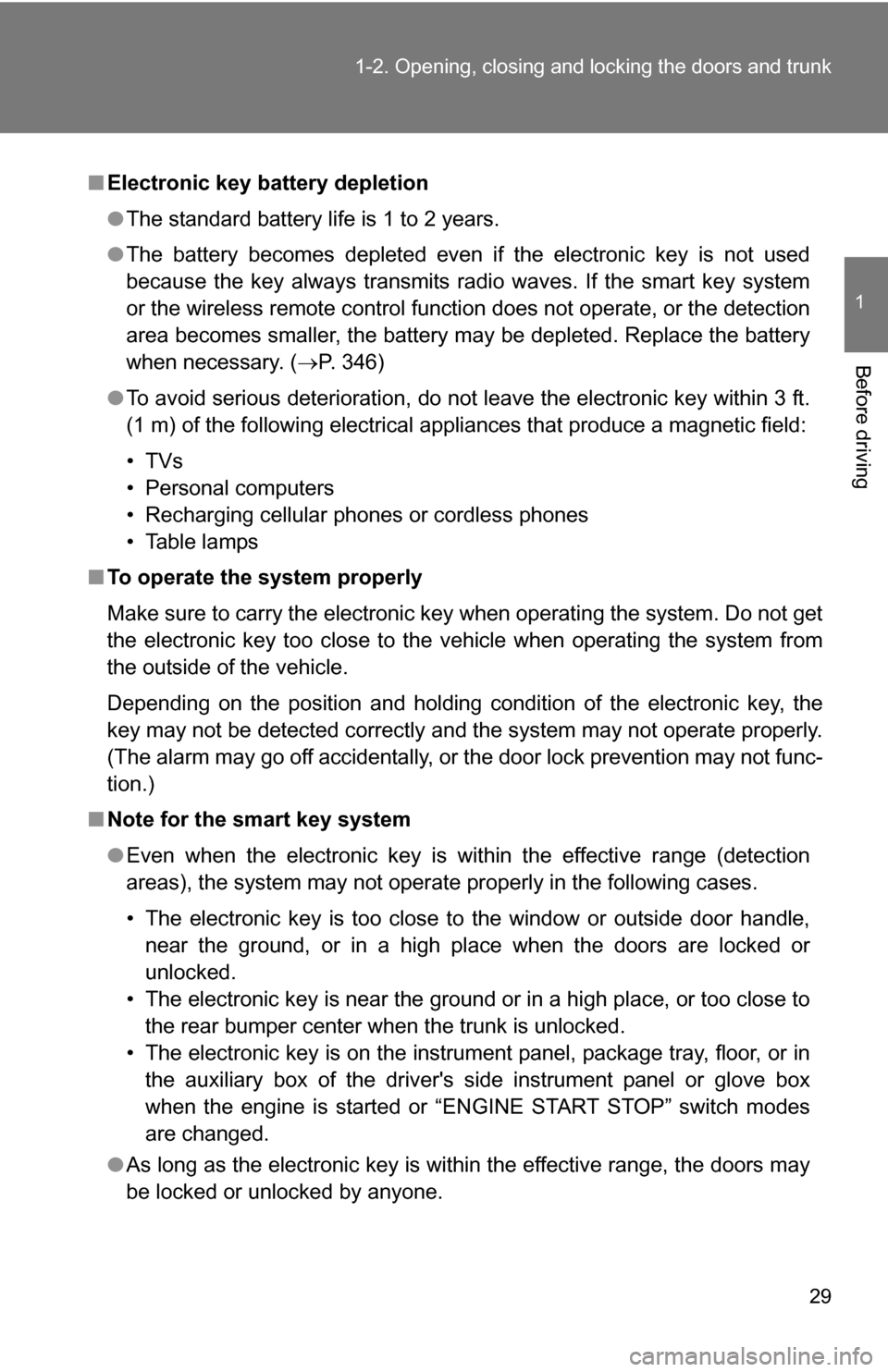
29
1-2. Opening, closing and locking the doors and trunk
1
Before driving
■
Electronic key battery depletion
●The standard battery life is 1 to 2 years.
● The battery becomes depleted even if the electronic key is not used
because the key always transmits radio waves. If the smart key system
or the wireless remote control function does not operate, or the detection
area becomes smaller, the battery may be depleted. Replace the battery
when necessary. ( P. 346)
● To avoid serious deterioration, do not leave the electronic key within 3 ft.
(1 m) of the following electrical appliances that produce a magnetic field:
•TVs
• Personal computers
• Recharging cellular phones or cordless phones
• Table lamps
■ To operate the system properly
Make sure to carry the electronic key when operating the system. Do not get
the electronic key too close to the vehicle when operating the system from
the outside of the vehicle.
Depending on the position and holding condition of the electronic key, the
key may not be detected correctly and the system may not operate properly.
(The alarm may go off accidentally, or the door lock prevention may not func-
tion.)
■ Note for the smart key system
●Even when the electronic key is within the effective range (detection
areas), the system may not operate properly in the following cases.
• The electronic key is too close to the window or outside door handle,
near the ground, or in a high place when the doors are locked or
unlocked.
• The electronic key is near the ground or in a high place, or too close to the rear bumper center when the trunk is unlocked.
• The electronic key is on the instrument panel, package tray, floor, or in the auxiliary box of the driver's side instrument panel or glove box
when the engine is started or “ENGINE START STOP” switch modes
are changed.
● As long as the electronic key is within the effective range, the doors may
be locked or unlocked by anyone.
Page 30 of 476
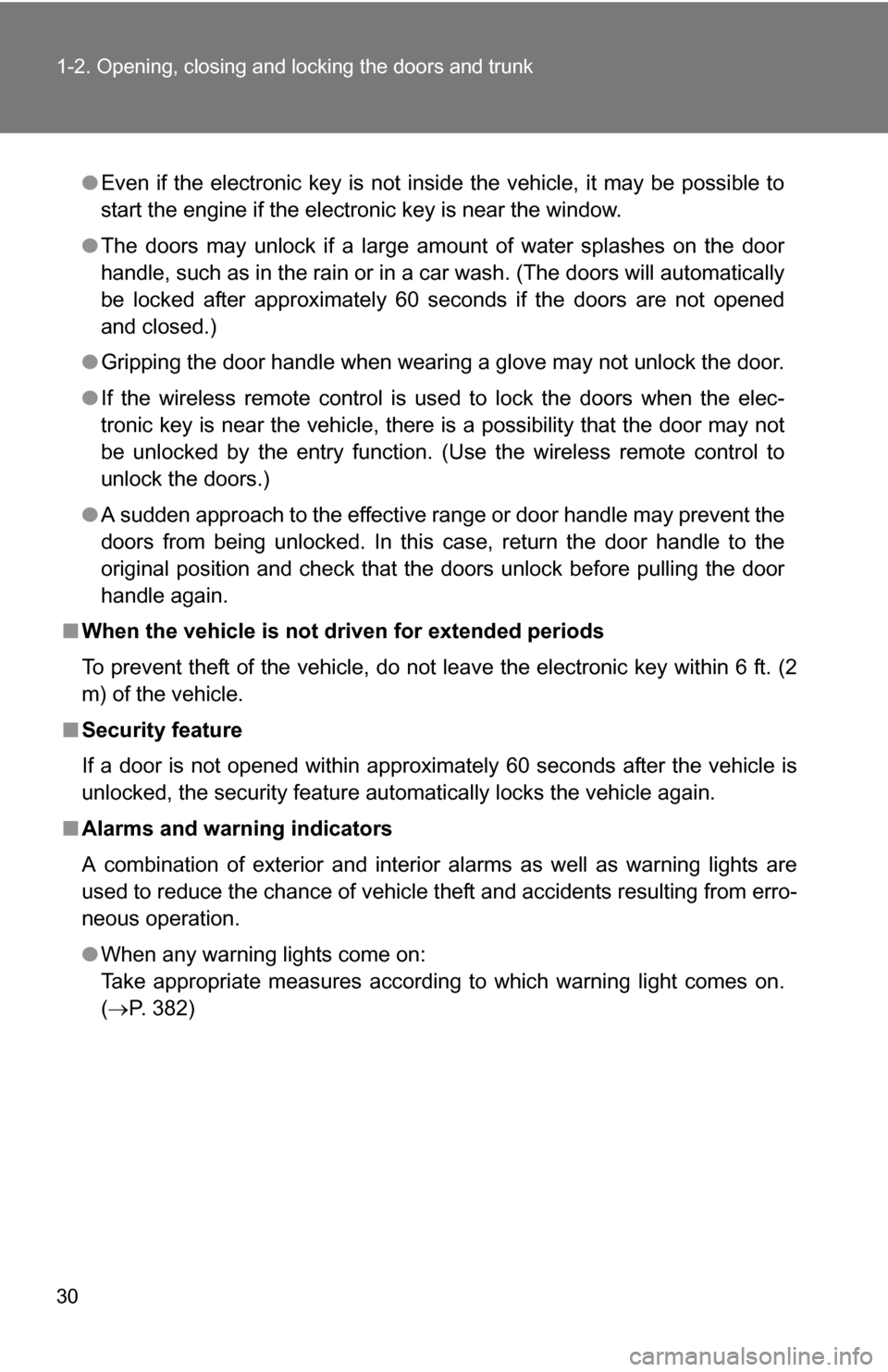
30 1-2. Opening, closing and locking the doors and trunk
●Even if the electronic key is not inside the vehicle, it may be possible to
start the engine if the electronic key is near the window.
● The doors may unlock if a large amount of water splashes on the door
handle, such as in the rain or in a car wash. (The doors will automatically
be locked after approximately 60 seconds if the doors are not opened
and closed.)
● Gripping the door handle when wearing a glove may not unlock the door.
● If the wireless remote control is used to lock the doors when the elec-
tronic key is near the vehicle, there is a possibility that the door may not
be unlocked by the entry function. (Use the wireless remote control to
unlock the doors.)
● A sudden approach to the effective range or door handle may prevent the
doors from being unlocked. In this case, return the door handle to the
original position and check that the doors unlock before pulling the door
handle again.
■ When the vehicle is not driven for extended periods
To prevent theft of the vehicle, do not leave the electronic key within 6 ft. (2
m) of the vehicle.
■ Security feature
If a door is not opened within approximately 60 seconds after the vehicle is
unlocked, the security feature automatically locks the vehicle again.
■ Alarms and warning indicators
A combination of exterior and interior alarms as well as warning lights are
used to reduce the chance of vehicle theft and accidents resulting from erro-
neous operation.
●When any warning lights come on:
Take appropriate measures according to which warning light comes on.
( P. 382)